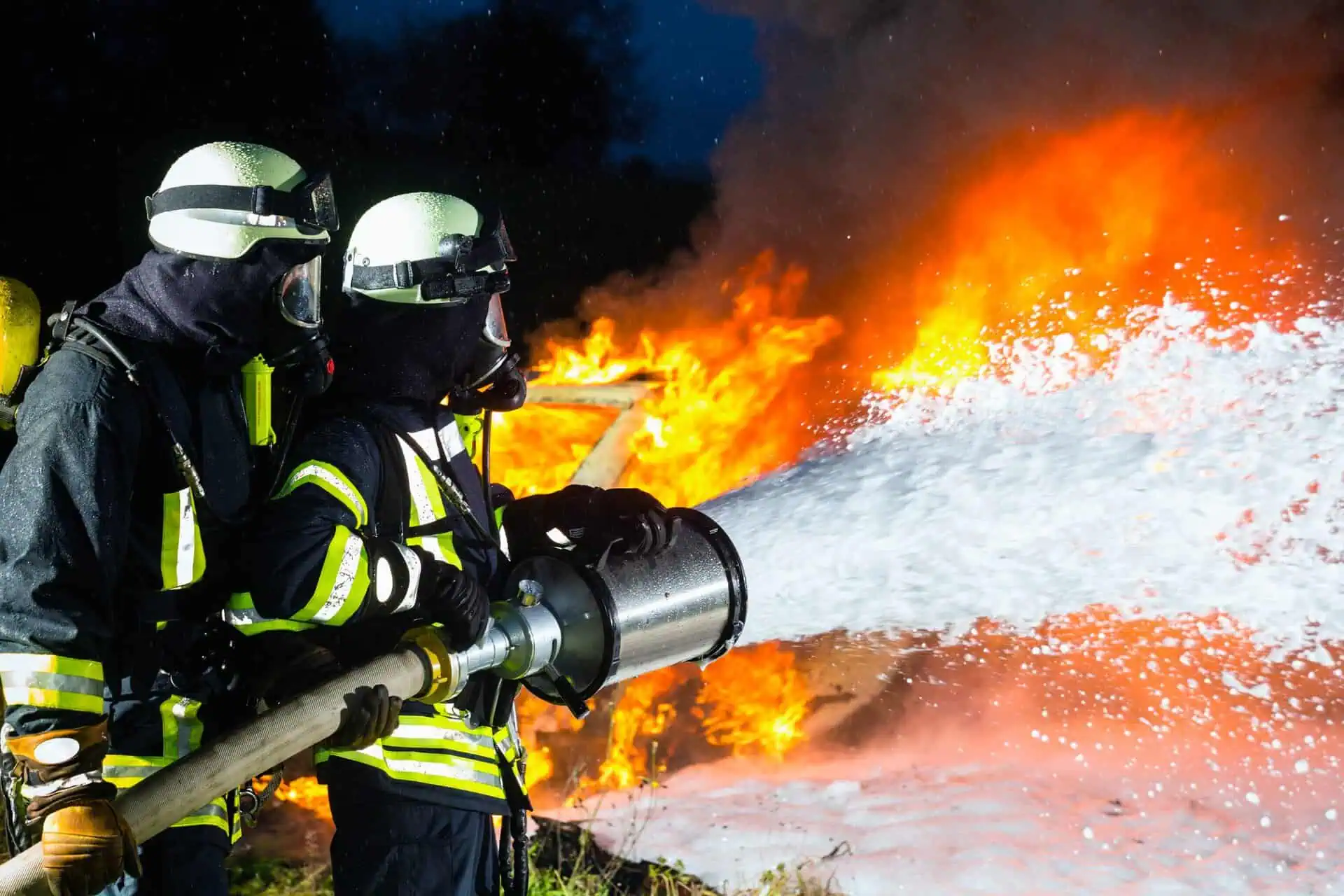How Do AFFF Lawsuit Tiers Work in the Firefighting Foam Lawsuit?
- Last Updated: June 12th, 2025

Attorney Jessica Paluch-Hoerman, founder of TruLaw, has over 28 years of experience as a personal injury and mass tort attorney, and previously worked as an international tax attorney at Deloitte. Jessie collaborates with attorneys nationwide — enabling her to share reliable, up-to-date legal information with our readers.
Legally Reviewed
This article has been written and reviewed for legal accuracy and clarity by the team of writers and legal experts at TruLaw and is as accurate as possible. This content should not be taken as legal advice from an attorney. If you would like to learn more about our owner and experienced injury lawyer, Jessie Paluch, you can do so here.
Fact-Checked
TruLaw does everything possible to make sure the information in this article is up to date and accurate. If you need specific legal advice about your case, contact us by using the chat on the bottom of this page. This article should not be taken as advice from an attorney.
Key takeaways:
- The AFFF lawsuit settlement is divided into three (3) tiers based on injury severity: Tier I ($300,000 to $600,000+) covers severe conditions like kidney and pancreatic cancer, Tier II ($100,000 to $300,000) addresses less aggressive cancers, and Tier III ($20,000 to $100,000) includes other AFFF-related illnesses.
- Military personnel, firefighters, and residents near military bases are primarily affected by AFFF exposure. Documented health risks include various cancers, immune system suppression, liver damage, and developmental delays due to PFAS "forever chemicals" in the foam.
- AFFF manufacturers are facing multi-district litigation (MDL) for allegedly not warning users about health risks associated with their products. A bellwether trial is set for June 5th, 2024. Concurrently, the Department of Defense plans to phase out PFAS-containing foams by 2024, opting for safer alternatives.
How Do AFFF Lawsuit Tiers Work in the Firefighting Foam Lawsuit?
Question: How do AFFF Lawsuit tiers work in the firefighting foam lawsuit?
Answer: The AFFF lawsuit tiers work by categorizing plaintiffs based on the strength of their case and severity of injuries.
Legal experts who are familiar with chemical exposure cases similar to the AFFF lawsuit are estimating settlement tiers to look something like the ranges seen below:
- Tier I AFFF lawsuit claims with the strongest cases and most serious cancers (such as kidney cancer) could receive settlements in the range of $300,000 to $600,000 (or more).
- Tier II AFFF lawsuit claims could potentially receive settlements in the range of $100,000 to $300,000.
- Tier III AFFF lawsuit claims with less severe injuries or weaker evidence may see settlements in the range of $20,000 to $100,000.
The figures and estimates provided above are in no way guarantees of settlement amounts for AFFF Firefighting Foam Lawsuit claims.
They are simply estimations based on average costs of healthcare expenses, personal damages, and costs of on-going care based on historic settlements from similar litigations.
AFFF lawsuit claims involve individuals, primarily firefighters and military personnel, who have been exposed to aqueous film-forming foam (AFFF) containing PFAS chemicals.
These legal actions arise from claims that AFFF manufacturers failed to warn users about the health risks associated with prolonged exposure to these toxic substances.
The litigation seeks to address the widespread contamination of water sources near military bases and firefighting training sites, where AFFF was extensively used.
Plaintiffs aim to hold manufacturers accountable for the alleged negligence in producing and marketing these products without adequate safety measures.
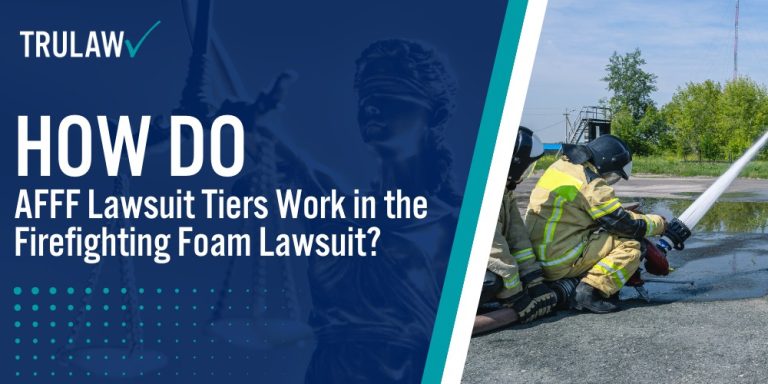
Lawyers Estimate AFFF Lawsuit Settlement Tiers
The lawsuits are being consolidated into multi-district litigation (MDL) to streamline the legal process and enhance the efficiency of case management, with a bellwether trial scheduled for June 5th, 2024.
Generally, cases are assigned to different tiers based on factors such as the type of injury, the extent of exposure to the harmful substance, and the overall impact on the plaintiffs’ lives.
This tiered system allows for plaintiffs with similar claims receive equitable treatment during the settlement process.
AFFF lawsuit tiers are estimated by legal experts to range between the following:
- Tier I: ($300,000 to $600,000 or more) – The injuries within the first tier of an MDL typically include the most severe medical conditions amongst plaintiffs, such as kidney or pancreatic cancer that have resulted from extensive occupational exposure to AFFF as a firefighter or in the military.
- Tier II: ($100,000 to $300,000) – This tier involves cases with significant long-term exposure and less aggressive forms of cancer, such as testicular or prostate cancer.
- Tier III: ($20,000 to $100,000) – For claims with less severe injuries or weaker evidence, the third tier of the AFFF lawsuit settlements may range from $20,000 to $100,000, depending on the severity of the illness and the length of exposure to AFFF.
Settlement tiers in multi-district litigation (MDL) are classifications used to categorize claims based on the severity of injuries and the circumstances surrounding each case.
The figures and estimates provided on this page are in no way guarantees of settlement amounts for the AFFF Firefighting Foam MDL.
They are simply generalized estimations based on average costs of healthcare expenses, personal damages, and costs of on-going care based on historic settlements from similar litigations.
If you or someone you love has been exposed to AFFF or PFAS chemicals and has suffered as a result, you may qualify to seek compensation in the AFFF lawsuit.
Contact TruLaw for an instant case evaluation that will determine your eligibility to join others in filing a lawsuit against AFFF manufacturers today.
Table of Contents
What are AFFF and PFAS Chemicals?
Per- and polyfluoroalkyl substances (PFAS), commonly known as “forever chemicals,” are a large group of synthetic chemicals recognized for their persistence in the environment and resistance to degradation.
PFAS have been widely used in various applications due to their water-resistant and non-stick properties, making them a staple in products like non-stick cookware, water-repellent fabrics, and, notably, firefighting foams.
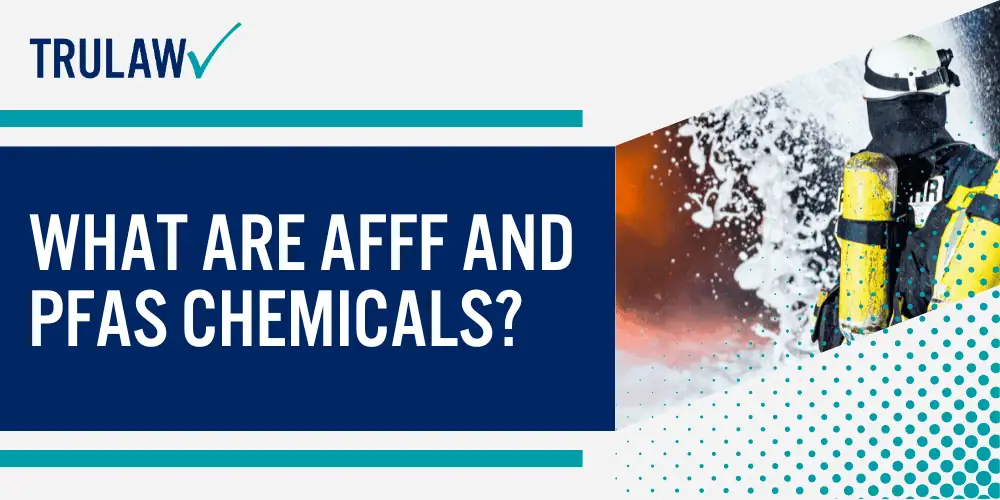
Aqueous film-forming foams (AFFF) are a specific type of firefighting foam that contains PFAS, designed to quickly suppress flammable liquid fires.
However, the use of AFFF, especially in military bases and airports, has led to significant environmental contamination, impacting water sources and food chains.
AFFF Foam and PFAS Contamination
AFFF, or aqueous film-forming foam, is a specialized firefighting foam that creates a barrier to extinguish fuel fires rapidly.
While effective in firefighting, AFFF contains PFAS compounds, leading to environmental contamination concerns as these chemicals persist and spread far from the initial application site.
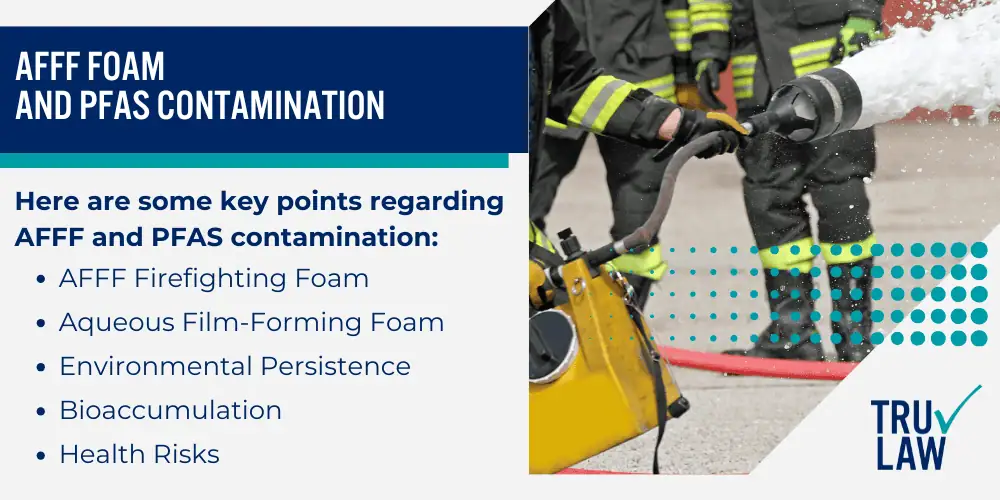
Here are some key points regarding AFFF and PFAS contamination:
- AFFF Firefighting Foam: Used primarily by military and firefighting services for liquid fires.
- Aqueous Film-Forming Foam: The foam forms a barrier, preventing oxygen from fueling fires.
- Environmental Persistence: PFAS in AFFF do not easily break down, remaining in the environment for decades.
- Bioaccumulation: PFAS compounds accumulate in fish and other aquatic species, affecting human and ecological health.
- Health Risks: Linked to adverse health outcomes, PFAS pose risks to communities through water and food chain contamination.
Studies have found PFAS contamination in fish up to 8 kilometers from known AFFF sources, highlighting the chemicals’ extensive reach and lasting impact on ecosystems.
Legal Actions Taken Against AFFF Manufacturers
In recent years, AFFF manufacturers have faced numerous lawsuits as awareness of PFAS-related health risks has grown.
Legal actions aim to hold these manufacturers accountable for environmental and health damages associated with PFAS contamination.
These lawsuits seek compensation and address claims that manufacturers were aware of the risks posed by PFAS but failed to take adequate safety measures.
Below are some primary aspects of the litigation against AFFF manufacturers:
- AFFF Firefighting Foam Lawsuits: Claims brought by individuals and municipalities over contamination.
- Firefighting Foam Lawsuits: Address contamination of water sources affecting residential areas.
- AFFF Litigation: Focuses on alleged negligence by manufacturers regarding PFAS risks.
- Health-Related Claims: Lawsuits include claims for health issues, such as cancer and immune system disorders.
- Environmental Impact: Many cases highlight the widespread environmental damage and the costs of cleanup efforts.
- Accountability and Compensation: Plaintiffs seek to cover the costs of medical treatment, monitoring, and cleanup.
These legal actions underscore the responsibility of AFFF manufacturers to address PFAS-related contamination issues and compensate affected communities.
The outcome of these lawsuits may influence regulations and the production practices surrounding PFAS and firefighting foams in the future.
Health Risks Associated with AFFF Exposure
Exposure to aqueous film-forming foams (AFFF) containing PFAS (per- and polyfluoroalkyl substances) is linked to various health risks, particularly for those in professions with regular AFFF contact, such as firefighters.
PFAS chemicals, often referred to as “forever chemicals,” persist in the environment and bioaccumulate in organisms.
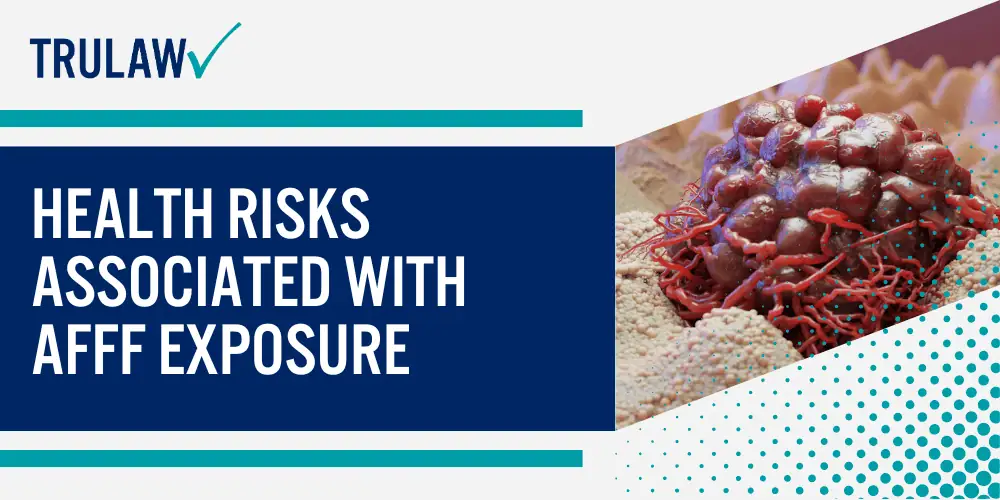
Despite declining in concentration over distance from a contamination source, PFAS levels in fish remain high enough to exceed health guidelines, highlighting the importance of monitoring PFAS exposure in watersheds affected by AFFF.
Types of Cancer Linked to PFAS Exposure
Studies have consistently linked PFAS exposure, particularly through AFFF, to an increased risk of several types of cancer.
Individuals exposed to PFAS through firefighting foam may be eligible to pursue firefighting foam cancer lawsuits to seek compensation for damages.
Additionally, AFFF cancer lawsuits offer avenues for legal redress, given the substantial body of evidence correlating PFAS to cancers such as kidney and testicular cancer.
The persistence of PFAS chemicals in the environment means exposure risks extend well beyond the immediate area of contamination, affecting broader communities and ecosystems.
Other Health Risks of AFFF Exposure
Beyond cancer, exposure to AFFF poses other serious health concerns.
This exposure encompasses a range of toxic chemicals known to disrupt metabolic, immune, and hormonal systems.
Here are additional health risks associated with AFFF exposure:
- Immune system suppression
- Liver damage and potential for elevated cholesterol levels
- Developmental delays in infants and children
- Increased risk of thyroid disease and hypertension in pregnant women
- Reduced vaccine efficacy and increased infection susceptibility
Occupational exposure to toxic chemicals in AFFF, especially in environments where firefighting foam is used extensively, makes monitoring PFAS levels critical for protecting at-risk populations.
AFFF Exposure in the Military
AFFF exposure is a critical health issue within the military due to the extensive use of firefighting foams containing PFAS chemicals at bases across the country.
The use of AFFF firefighting foams is common in training and emergency response situations across all military branches—Navy, Army, Marines, and Air Force.
These foams, containing per- and polyfluoroalkyl substances (PFAS), were initially valued for their effectiveness in quickly extinguishing fuel-based fires, particularly around aircraft and high-risk fuel storage areas.
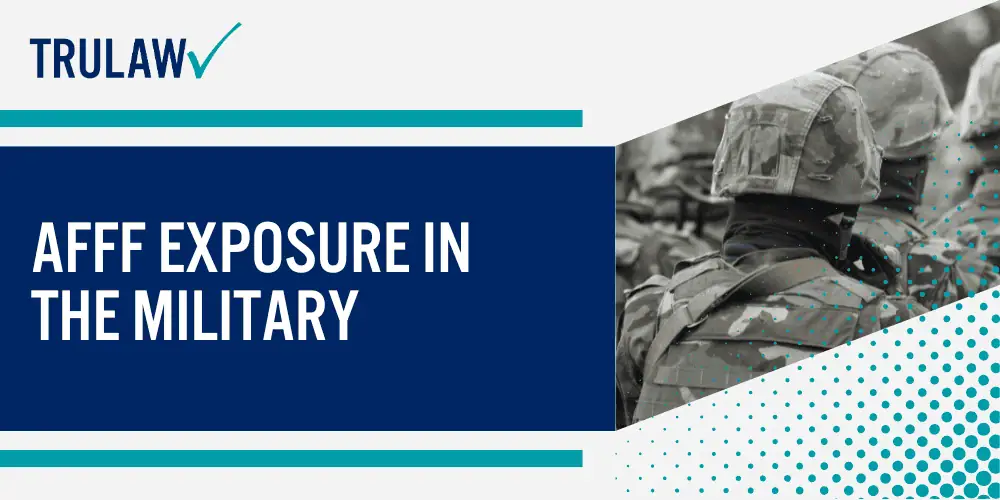
However, it is now well-documented that PFAS chemicals remain in the environment and accumulate in water sources and biological tissues, creating long-term contamination risks.
Exposure by Branch: Navy, Army, Marines, Air Force
Each military branch has historically used supplied AFFF firefighting foam in fire suppression systems, training exercises, and emergency responses.
As a result:
- Navy: Naval bases, often located along coastlines and near populous areas, have high contamination risks from PFAS as foams are frequently used in ship and aircraft operations.
- Army: Army facilities, particularly those involved in vehicle maintenance and fueling operations, face similar exposure risks due to routine use of AFFF.
- Marines: Marine Corps bases also rely on AFFF, especially around airstrips and vehicle depots, further exposing soldiers and surrounding communities.
- Air Force: Due to extensive airfield operations, the Air Force has widespread AFFF use, leading to PFAS contamination at numerous air bases.
In each branch, the handling and deployment of AFFF has led to both immediate and sustained exposure to PFAS for military personnel and nearby residents, often with limited mitigation efforts available.
PFAS Chemicals Discovered at Military Bases Nationwide
PFAS contamination from AFFF firefighting foams has been identified at hundreds of military bases across the United States.
PFAS compounds in these foams are highly persistent, leading to environmental contamination that extends miles beyond the original point of use.
For communities surrounding military installations, these chemicals have infiltrated drinking water sources and local ecosystems.
Studies highlight that PFAS levels in fish, surface water, and groundwater often exceed health guidelines, signaling a need for enhanced monitoring and intervention.
Consequently, communities and veterans impacted by AFFF exposure at these sites may have grounds for legal action, as AFFF contamination poses significant public health risks.
Manufacturers of AFFF and Modern Alternatives
The production and widespread use of aqueous film-forming foam (AFFF) has been primarily driven by several large chemical manufacturers who supplied the military, airports, and fire departments across the United States.
While AFFF was initially praised for its firefighting effectiveness, especially in high-risk fuel and aircraft fires, recent research on PFAS contamination has led to significant allegations against these manufacturers.
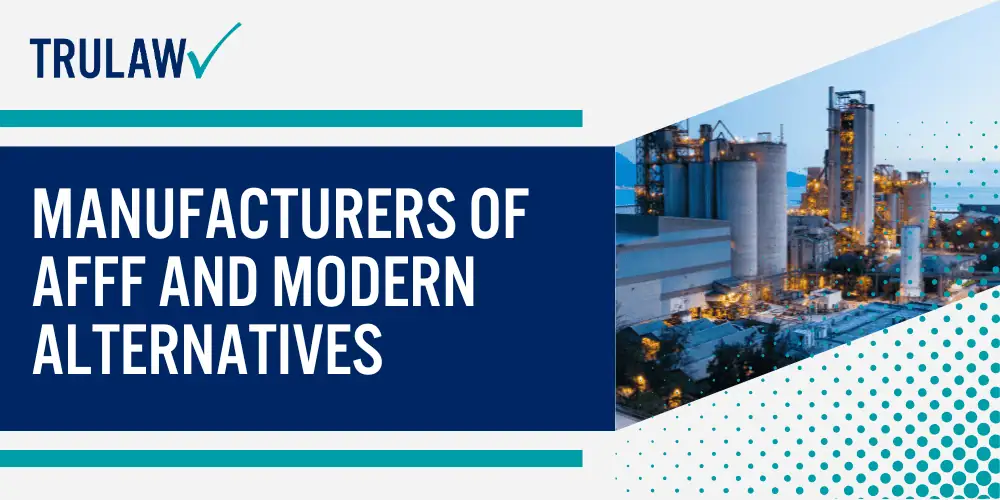
The environmental persistence of PFAS compounds in AFFF and their harmful effects on health and ecosystems have become the foundation for numerous lawsuits, urging these companies to be held accountable for the contamination caused by their products.
Allegations Against AFFF Manufacturers
AFFF manufacturers, including major chemical corporations, face significant legal challenges as the link between PFAS exposure and serious health risks becomes increasingly evident.
AFFF firefighting foam cases center around the failure of these companies to warn users of the potential risks associated with PFAS.
Many AFFF lawsuits allege that manufacturers knew of the environmental and health dangers of PFAS but continued production without adequate safety warnings or alternatives.
These lawsuits aim to secure compensation for individuals suffering from PFAS-related health issues, including various cancers and immune disorders, and to address the long-term environmental impacts of AFFF usage.
Phasing Out AFFF Firefighting Foam Use
With mounting evidence against PFAS-laden firefighting foam, there is a concerted effort to phase out AFFF in favor of safer, non-PFAS alternatives.
Several countries and states have started to implement bans or restrictions on AFFF usage, while the U.S. Department of Defense has committed to replacing AFFF with environmentally friendly options by 2024.
These alternative foams are designed to meet firefighting standards without the health and environmental risks associated with PFAS, marking a critical shift toward safer firefighting practices.
The transition reflects a growing recognition of the need to protect firefighters, military personnel, and communities from prolonged exposure to harmful chemicals, prioritizing sustainable solutions in fire safety.
TruLaw: Your Firefighting Foam Toxic Exposure Law Firm
AFFF firefighting foam lawsuits are being filed by individuals across the country who were exposed to toxic chemicals found in film forming foam AFFF and subsequently developed cancer or other adverse health effects.
TruLaw is currently accepting clients for the AFFF litigation.
A few reasons to choose TruLaw for your AFFF lawsuit include:
- If We Don’t Win, You Don’t Pay: The AFFF attorneys at TruLaw and our partner firms operate on a contingency fee basis, meaning we only get paid if you win.
- Expertise: Our legal team has years of experience handling chemical exposure cases similar to the AFFF litigation, which helps us anticipate what we can expect to see in your case and the regulations we will be required to meet.
- Successful Track Record: TruLaw and our partner law firms have helped our clients recover billions of dollars in compensation through verdicts and negotiated settlements.
If you or a loved one were exposed to toxic firefighting foam and subsequently diagnosed with cancer or experiencing serious health risks, you may be eligible to seek compensation.
Contact TruLaw using the chat on this page to receive an instant case evaluation that can determine if you qualify for the AFFF firefighting foam lawsuit today.
AFFF Lawsuit Frequently Asked Questions
-
What are the settlement tiers in the AFFF lawsuit and how much compensation can plaintiffs receive?
The AFFF lawsuit settlement is divided into three tiers with Tier I ($300,000 to $600,000+) for severe conditions like kidney cancer, Tier II ($100,000 to $300,000) for less aggressive cancers, and Tier III ($20,000 to $100,000) for other AFFF-related illnesses.
These amounts are estimates based on factors including injury severity, exposure duration, and healthcare costs.
-
Who is most at risk for AFFF exposure and related health issues?
Military personnel, firefighters, and residents near military bases are the primary groups affected by AFFF exposure.
These individuals face increased risks of various cancers, immune system suppression, and liver damage due to prolonged exposure to PFAS chemicals in firefighting foam.
-
What are PFAS chemicals and why are they dangerous?
PFAS chemicals are synthetic substances known as “forever chemicals” that persist in the environment and resist degradation.
These chemicals can bioaccumulate in organisms, leading to serious health risks including cancer, developmental delays, and immune system disorders.
-
When will the military stop using AFFF containing PFAS?
The U.S. Department of Defense has committed to phasing out PFAS-containing firefighting foams by 2024.
This transition includes replacing current AFFF supplies with safer, environmentally friendly alternatives that don’t contain harmful PFAS chemicals.
-
What types of cancer are linked to AFFF exposure?
AFFF exposure has been linked to several types of cancer, including kidney cancer, pancreatic cancer, testicular cancer, and prostate cancer.
The risk of developing these cancers is particularly high for individuals with extensive occupational exposure to AFFF.
-
How has AFFF contamination affected military bases?
PFAS contamination from AFFF has been discovered at hundreds of military installations nationwide, affecting both groundwater and drinking water sources.
The contamination extends miles beyond the original point of use, impacting both military personnel and nearby communities.

Managing Attorney & Owner
With over 25 years of legal experience, Jessica Paluch-Hoerman is an Illinois lawyer, a CPA, and a mother of three. She spent the first decade of her career working as an international tax attorney at Deloitte.
In 2009, Jessie co-founded her own law firm with her husband – which has scaled to over 30 employees since its conception.
In 2016, Jessie founded TruLaw, which allows her to collaborate with attorneys and legal experts across the United States on a daily basis. This hypervaluable network of experts is what enables her to share the most reliable, accurate, and up-to-date legal information with our readers!
Additional AFFF Lawsuit resources on our website:
Here, at TruLaw, we’re committed to helping victims get the justice they deserve.
Alongside our partner law firms, we have successfully collected over $3 Billion in verdicts and settlements on behalf of injured individuals.
Would you like our help?
At TruLaw, we fiercely combat corporations that endanger individuals’ well-being. If you’ve suffered injuries and believe these well-funded entities should be held accountable, we’re here for you.
With TruLaw, you gain access to successful and seasoned lawyers who maximize your chances of success. Our lawyers invest in you—they do not receive a dime until your lawsuit reaches a successful resolution!
AFFF Lawsuit claims are being filed against manufacturers of aqueous film-forming foam (AFFF), commonly used in firefighting.
Claims allege that companies such as 3M, DuPont, and Tyco Fire Products failed to adequately warn users about the potential dangers of AFFF exposure — including increased risks of various cancers and diseases.
Depo Provera Lawsuit claims are being filed by individuals who allege they developed meningioma (a type of brain tumor) after receiving Depo-Provera birth control injections.
A 2024 study found that women using Depo-Provera for at least 1 year are five times more likely to develop meningioma brain tumors compared to those not using the drug.
Suboxone Tooth Decay Lawsuit claims are being filed against Indivior, the manufacturer of Suboxone, a medication used to treat opioid addiction.
Claims allege that Indivior failed to adequately warn users about the potential dangers of severe tooth decay and dental injuries associated with Suboxone’s sublingual film version.
Social Media Harm Lawsuits are being filed against social media companies for allegedly causing mental health issues in children and teens.
Claims allege that companies like Meta, Google, ByteDance, and Snap designed addictive platforms that led to anxiety, depression, and other mental health issues without adequately warning users or parents.
Transvaginal Mesh Lawsuits are being filed against manufacturers of transvaginal mesh products used to treat pelvic organ prolapse (POP) and stress urinary incontinence (SUI).
Claims allege that companies like Ethicon, C.R. Bard, and Boston Scientific failed to adequately warn about potential dangers — including erosion, pain, and infection.
Bair Hugger Warming Blanket Lawsuits involve claims against 3M — alleging their surgical warming blankets caused severe infections and complications (particularly in hip and knee replacement surgeries).
Plaintiffs claim 3M failed to warn about potential risks — despite knowing about increased risk of deep joint infections since 2011.
Baby Formula NEC Lawsuit claims are being filed against manufacturers of cow’s milk-based baby formula products.
Claims allege that companies like Abbott Laboratories (Similac) and Mead Johnson & Company (Enfamil) failed to warn about the increased risk of necrotizing enterocolitis (NEC) in premature infants.
Here, at TruLaw, we’re committed to helping victims get the justice they deserve.
Alongside our partner law firms, we have successfully collected over $3 Billion in verdicts and settlements on behalf of injured individuals.
Would you like our help?
